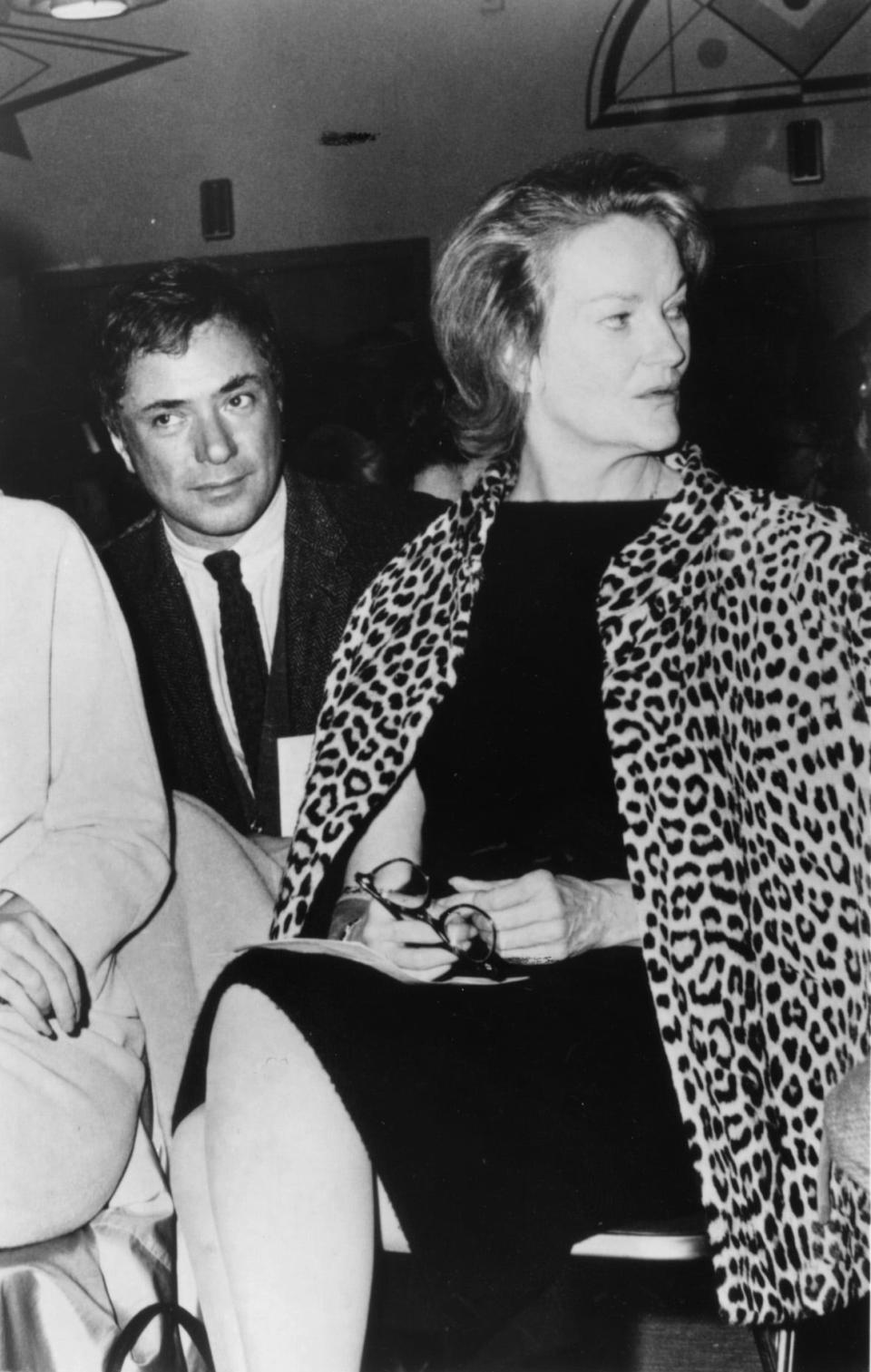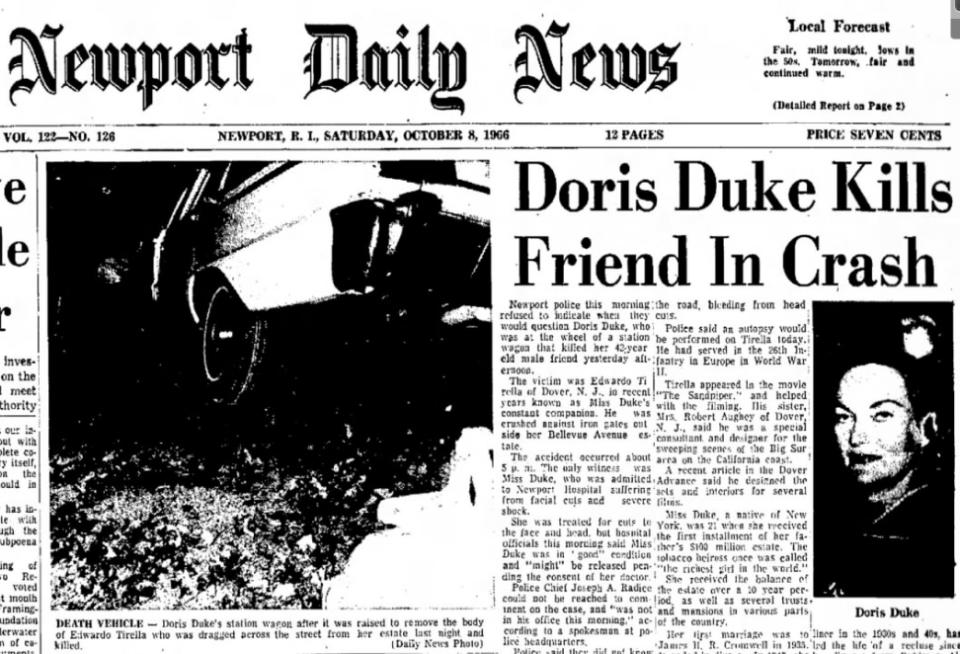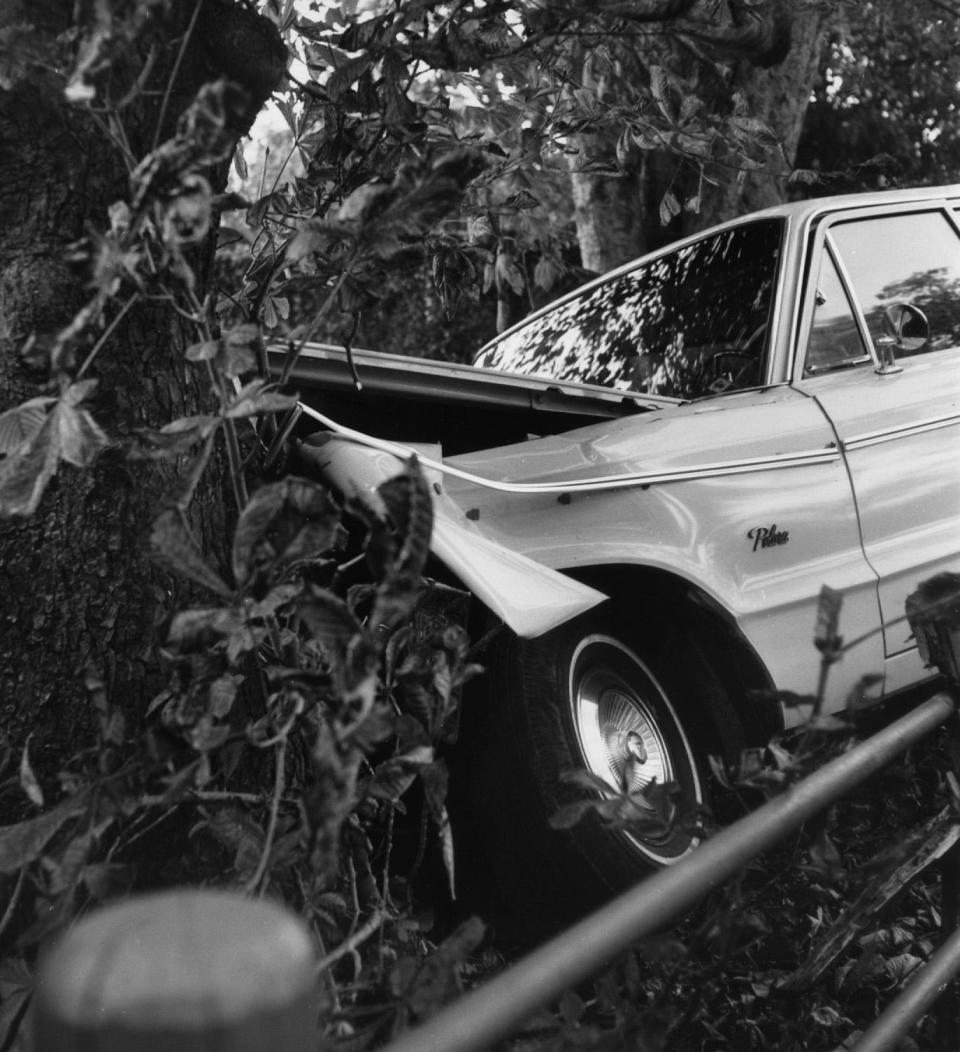Newport police close case of 1966 Doris Duke crash that killed Eduardo Tirella — again
NEWPORT — The Police Department on Thursday closed a review of its previous finding that Doris Duke killed her employee, Eduardo Tirella, in an “unfortunate accident” in 1966.
The department opened the review at the beginning of July because of new evidence discovered by Peter Lance, author of “Homicide at Rough Point," a book published earlier this year that claims Duke’s actions showed intent to kill.
Bob Walker, a Newport Daily News paperboy at the time who arrived at the scene seconds after the crash, came forward and confirmed to police Lance’s portrayal of the incident.
Cold-case detective Jacque Wuest, assigned to conduct the review, sent an email to Lance on Thursday that said “my conclusion is there is no new evidence that would change the previous conclusion in this matter, nor is there any new evidence that warrants further review.”
Wuest recently was promoted to traffic sergeant.
Lance, who has a law degree, called the conclusion of the case “outrageous.” He believed the accumulation of evidence provided to police would justify a finding of fact, that the death of Tirella on Oct. 7, 1966, outside the gates of Duke's Rough Point mansion, “was proximately caused by a series of intentional acts committed by Doris Duke.”

Since Duke, a billionaire tobacco heiress, died in 1993, there could be no guilty finding.
More: Did Doris Duke kill her employee Eduardo Tirella? Newport police 'follow-up' on 1966 crash
“I’m shocked and overwhelmed,” Walker told The Daily News in reaction to Wuest's closing of the case. “I’ve carried this in my heart for 55 years. It’s extremely personal to me. I put my personal reputation at stake to step forward and give this testimony. It wasn’t without an awful lot of heartache and thought. The evidence is overwhelming. What do you need — Doris Duke to come knocking on your door and say, ‘OK, I did it?'"
Newport police reopened the case after witness Bob Walker came forward
Walker called police on July 1 and was interviewed by Wuest the next day for more than two hours. He said he witnessed the events surrounding the crash and gave her contact information for multiple people who could corroborate his story back to the early 1970s.
“I have spoken to most of these parties, who have confirmed what Mr. Walker told me, therefore finding Mr. Walker’s account of the incident on Oct. 7, 1966, credible,” Wuest said afterward in an email.
More: Rough Point exhibit detailing Doris Duke's killing of Eduardo Tirella modified in light of book
Wuest opened her email Thursday by quoting from her Aug. 2 email when she said the department would like “to rectify any possible information concluded in the past, if any,” and that “we would love to bring justice for Eduardo and his family.”
Police officially determined in 1966 that Tirella was crushed against the iron gates, dragged across Bellevue Avenue and pinned under the car when it struck a tree. That is a conclusion Lance refutes, based on his interviews with Newport police who initially investigated the incident and the state medical examiner’s findings.
Tirella had no lower-body injuries except a broken hip, consistent with another police theory of the accident uncovered by Lance.
For his book, Lance interviewed Edward Angel, the first police officer on the scene, who worked with Sgt. Fred Newton, the accident investigator. Wuest interviewed Angel on Sept. 24. Lance obtained recordings of her interviews with both Angel and Walker, and made transcripts of them that he has sent to Wuest, city officials and The Daily News.
More: 'Homicide at Rough Point' review: Tales of old Newport abound in examination of Doris Duke killing
According to Angel, Newton believed Tirella went up on the hood of the station wagon driven by Duke before it hit the gate of her mansion, Rough Point. “That was his theory of the crash,” Angel said. “Then at some point after the gates blew open, she hesitated, tapped the brakes and he rolled off. At that point he was run over by the vehicle and dragged to the point where he was still underneath it when it hit the tree.”
Newton “showed me markings on the gates that suggested somebody had been forced up on the hood of the car,” Angel said. “Then he walked me into the middle of Bellevue, explaining that the blood and the skin I’d found were from when the victim rolled off and fell in front of the car.”

Based on his recollections of what he heard and saw first-hand at Rough Point, Walker confirmed this is what happened.
Tirella drove a Polara station wagon to the Rough Point gates to leave with Duke, who was in the passenger seat, according to the police report and Duke’s own statements to police. She said she slid over to the driver’s seat and hit the accelerator by mistake, hitting Tirella.
Walker first heard a man and woman arguing at the gates.
“The arguing stopped for a couple of seconds,” Walker said “and the next thing I heard was the roar of a motor, the crash and the screaming of a man.”
Walker then heard “a deceleration of the motor and a slight skid.”
That’s when, in Newton’s view as related to Angel, Duke had tapped the brakes and Tirella rolled off onto Bellevue Avenue, having sustained a broken right hip, but still alive.
Walker then heard the man “scream again and the roar of the motor,” at which point, he says, the man’s wail turned to horror and he screamed, ‘Nooooo…. ”
After the wagon crashed on the other side of Bellevue Avenue, Walker saw the woman get out of the car.
“When she got out, she took, like, six or seven steps," he said. "Quick and deliberate. She then spun around looking at the car.”
“She spun around and looked at me,” Walker said. “I said, ‘Can I help you, ma’am?’ And she said, while screaming and pointing her finger, ‘You better get the hell out of here!’"
Walker said Duke had no injuries on her face when she yelled at him. Angel found her sitting at the steering wheel with facial injuries consistent with hitting the steering wheel, and apparently in trauma.
Lance speculates that Duke may have heard the police sirens coming, got back in the car, and intentionally banged her face on the steering wheel as she prepared for escaping responsibility.
Angel told Wuest that he thought it was an accident until the former paperboy came forward, which has created doubt for him.
“And if, in fact, she was outside that car before I got there, uninjured — and what I observed, when I got there — it gives you a sense that maybe there was intent, and an intent to cover up what had happened,” Angel said, according to the transcript.
When Duke entered Newport Hospital the night of Tirella’s death, Dr. Philip C. McAllister, the acting state medical examiner, agreed to become her personal doctor. He promptly placed her in a secure, private room, which made it impossible for state investigators to question her.
Author Peter Lance sends timeline, evidence to Newport city officials
Lance pieced together a 30-page timeline of the Newport police review of the case this year and sent it to Wuest, City Manager Joseph J. Nicholson Jr., and just recently, all seven city councilors, questioning why the investigation was entering its fifth month.
In the timeline, he provided links to the Walker and Angel transcripts, as well as other documents in the case.
Lance made the argument there were a series of intentional acts by Duke that led to Tirella’s death:

According to Lance, she slid behind the wheel of the Polara, something her caretaker Harold McFarlane told state Registry of Motor Vehicles investigators she never did when leaving the estate. She released the hand brake on the 1966 Dodge Polara by hand. She shifted from park to drive.
“She then slammed down on the accelerator, leaving tire-wide gouges in the gravel driveway photographed by Eduardo’s brother-in law Robert Aughey the next day — photos of which (now missing) were entered into evidence at the 1971 wrongful death civil trial in Providence in which Miss Duke was found liable for Eduardo’s death,” Lance wrote in an email sent to police and city officials.
The station wagon burst through the wrought iron gates, according to Lance, knocking out five of the baluster rungs in the lower portions of the gates and bending them over a metal “stop” at the foot of the driveway before getting onto Bellevue Avenue.
"She then hesitated, tapping the brakes, at which point, injured but alive, Eduardo rolled off onto Bellevue," he wrote. "Then, after a few moments, Duke decided to commit and roared forward, dragging him across the avenue. The wagon mounted the curb, knocked down 20 feet of post and rail fence on Quatrel, the estate across the street, before veering left and crashing into a tree with Tirella dead under the rear axle.
“Therefore his death, as determined by Sgt. Newton, from the moment she slid behind the wheel, was the result of six intentional acts,” Lance wrote.
“Police denying the evidence is startling,” Lance said in a telephone interview. “Having covered law enforcement at the local, state and federal level for nearly 50 years, including writing four books on the FBI in the areas of counterintelligence and organized crime, it is often the case that the police just do not want to revisit their mistakes. Negligence begets gross negligence, which becomes obstruction of justice when they won’t update history.”
This article originally appeared on Newport Daily News: Newport RI police close review of 1966 Doris Duke fatal car crash

